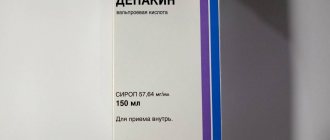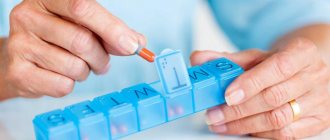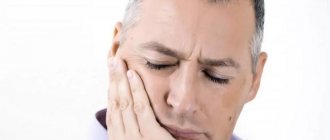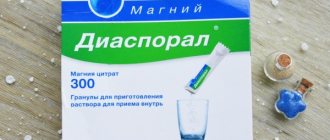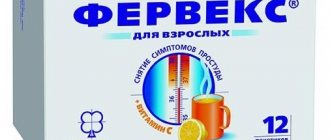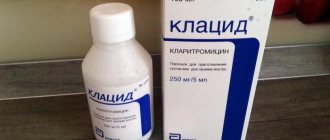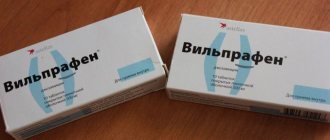Synonyms: Belladonna
The homeopathic medicine “Belladonna” is obtained from a plant of the nightshade family with the same name. Belladonna is also called henbane, belladonna, wolfberry, witch's grass, devil's berries, devil's cherry, naughty cherry, black buds. It contains strong poisons. They can lead to a painful death, but when used correctly they can be a good medicine that saves you from many ailments. The areas of application are varied: nervous system, respiratory tract, digestive system, rheumatism.
All parts of the plant are used: leaves, stems, roots, flowers. Our ancestors learned to make medicinal tinctures from belladonna more than 1500 years ago, and to this day the plant is widely used both in folk medicine and homeopathy, and in pharmacology. The description of the homeopathic drug “Belladonna” first appeared in the work of the founder of homeopathy “Pure Medicine” S. Hahnemann. Here he devoted 53 pages to this plant, where he described its properties and effects on humans. All these random and planned experiments led him to the conclusion that the medicine had a very strong effect on the nervous system.
However, there are plenty of other descriptions of the consequences of taking this plant in old books. Here is one of them: “For those who carelessly ate berries, one can predict the sequence of further events - complete loss of voice, constant restless movements, inability to swallow, in addition to a strong feeling of thirst, visual impairment when the patient catches imaginary objects with his hands, delirium turning into insensibility, and ultimately death.”
Despite the severity of its effects, the word "Belladonna" means something beautiful. It is believed that it came from the combination “bella donna”, which in Russian sounds like “beautiful woman”. In the 16th century, Italian women used the juice of the plant to drop into their eyes to dilate their pupils. Then it was believed that this way the gaze becomes more expressive, and, therefore, the woman herself becomes more attractive to the opposite sex.
What is belladonna?
Belladonna is a perennial herbaceous plant reaching a height of 2 meters. The flower family is Solanaceae. The plant has very powerful roots, a wide and straight green stem, sometimes taking on a purple tint.
It grows most often in the mountains: the Carpathian Mountains, the Crimean Mountains, the Caucasus. Can be found in Asia, Pakistan, USA and Afghanistan.
Chemical composition
The flower contains many substances, thanks to which it has become so widely known.
The main components that make up the plant:
| Stimulating the nervous system | Paralyzing nerve endings |
| Apoatropine | Atropine |
| Hyoscine | Belladonnin |
The substances are contained in small quantities and are harmless in small doses, but it should be remembered that the flower is poisonous, and an overdose of the substances described above can be fatal.
History of the origin of the name belladonna
Belladonna Belladonna in Latin sounds like Atropa Belladonna L. The name Belladonna from Italian bella and donna translates as “beautiful woman.” This is explained by the fact that women in Italy used the juice of these wild plants for cosmetic purposes. They dropped it into the eyes, as a result of which the pupils dilated and the eyes gained shine. They also rubbed the juice on their cheeks and a blush appeared on them.
The generic name Atropa from Greek means “unyielding.” This was the name of one of the ancient Greek goddesses of fate, who could mercilessly cut the thread of a person’s life. Belladonna belladonna deserves this name due to its poisonous properties.
Let's take a little dip into history and find out what this plant has been famous for over the centuries.
We find mention of belladonna in the 3rd century BC. e. Its poisonous and healing properties were described by Theophrastus. Later Dioscorides gave the name belladonna - “crazy plant”. Warriors of ancient Germanic tribes wore bear skins, took a drink with belladonna, which led to strong excitement, and fearlessly fought with enemies. In the Middle Ages, poison was prepared from belladonna. An interesting story from history tells how, thanks to this plant, the Scots defeated the Danes. The Scots feigned a retreat and left barrels of beer, to which belladonna juice was added. The Danes, rejoicing in their victory, drank this drink, fell fast asleep, and the Scots returned and dealt with their enemies.
Belladonna was credited with magical properties due to its ability to cause hallucinations. Witchcraft potions and ointments were prepared from belladonna. Women who thought they were witches drank the potion or used the ointment. The result was not long in coming. It seemed to them that they were flying, visions appeared - in general, they had the feeling that they were really at a gathering of witches.
At the same time, already in the Middle Ages, belladonna began to be used for medical purposes, and over time, more and more useful properties were discovered, which will be discussed further.
So, on the one hand, this wild plant is very poisonous and can lead to death. On the other hand, in modern medicine it is used to make drugs used in a variety of fields. Let's take a closer look at belladonna and first pay attention to its appearance.
Medicinal properties
Belladonna (indications for use and features of use of which will be described in the article) thanks to its components can quickly relieve painful sensations. The components of the flower have the ability to paralyze nerve endings, reduce the secretion of glands, calm intestinal motility, and accelerate the activity of the cardiovascular system.
As an analgesic and antispasmodic drug, belladonna is included in a complex of medications to combat the following diseases:
- Renal colic.
- Spasms of the intestinal tract and urinary tract.
- Sweating due to tuberculosis.
- Cholecystitis.
- Persistent cough.
Indications for use in homeopathy
Belladonna acts on the human body in the following way: it activates the nerve centers, while paralyzing the peripheral nerves.
In homeopathy it is used as an analgesic and reduces sensitivity to symptoms in such cases:
- Acute diseases affecting the respiratory organs - sore throat, whooping cough, inflammation of the tonsils and pharynx, dry cough.
- Infectious diseases - scarlet fever.
- Skin diseases.
- Rheumatism.
- Diseases of the gastrointestinal tract (colic or appendicitis).
- Inflammation of the ovaries, urinary tract, urinary incontinence.
- Fever, headaches.
Side effect
For systemic use:
Possible headache, nervousness, drowsiness, weakness, dizziness, sleep disorders, ataxia, speech impairment, agitation (especially in elderly patients), dry mouth, loss of taste, loss of appetite, constipation.
In case of overdose:
nausea, vomiting, tachycardia, tachyarrhythmia, myocardial ischemia, impotence, suppression of lactation, idiosyncrasy, urticaria, decreased sweating, hyperthermia.
For local use:
visual impairment, mydriasis, paralysis of accommodation, increased intraocular pressure, photophobia.
Plant for women
Belladonna, the indications for use of which vary depending on the typology of the disease and age, as well as gender, helps women cope with various diseases.
They are as follows:
- Hemorrhoids, anal fissures.
- Vision problems. The plant has been used to dilate pupils since ancient times. Manufacturers of eye drops still use belladonna extract.
- The plant acts as a pain reliever during menstruation.
Analogs
Analogs of suppositories that match the ATC code of the 4th level and contain belladonna extract together with other medicinal components:
Analogue of the drug
- Anuzol;
- Betiol;
- Hemorrhoids;
- Hemorrhoids (ointment).
The cost of the drug in pharmacies in Moscow and Russian cities is 26-68 rubles.
Belladonna suppositories are an antispasmodic and anti-inflammatory agent. They effectively eliminate the manifestations of hemorrhoids and help women during childbirth. According to the opinions and reviews of many patients, it is these suppositories that perfectly heal cracks in the anus and rectum. But thoughtless use is unacceptable. Belladonna is a poisonous herb. Instead of benefit, it can undermine health and destroy vital organs.
Use during pregnancy and lactation
The flower has an effect on the degree of contraction of smooth muscles, including uterine ones. Therefore, the use of the plant during pregnancy should be strictly regulated by the supervising doctor. Belladonna extract is prescribed to pregnant women to prevent prolonged labor.
During lactation, you should refrain from consuming the plant - there is a risk of the so-called “burnt milk effect” - the cessation of product production by the mammary glands, caused by an undesirable tonic effect on the nerve centers of the cerebral cortex.
Uses of belladonna
For febrile conditions
Belladonna relieves fever, relieves pain, and reduces the urge to cough. It is used as a tincture with a low concentration of the substance - no more than 2 mg. You need to take this once, no more than a glass. The procedure can be repeated only the next day.
Feverish seizures occur suddenly and abruptly put the body into a critical state. But exceeding the dose to achieve a faster effect is contraindicated - there is a risk of worsening the situation.
For skin problems
The flower will help cope with problematic skin conditions such as burns (only 1st degree lesions), rashes, painful insect bites with the appearance of tumors and irritation. For this, a solution with a concentration of 0.5 tsp is used. dry herbs per 500 ml of warm liquid. It is necessary to wipe the affected areas 3 times a day.
For muscle and headache pain
Belladonna can be used as an analgesic to relieve headaches and muscle pain. The plant relieves pain after intense physical exertion and muscle strain. Used in tablets or infusions.
The exact dose is prescribed by a homeopath or local doctor.
For indigestion
For problems with the gastrointestinal tract, the flower has a calming effect on the organs - belladonna paralyzes peripheral nerve endings. Spasms disappear, the stomach relaxes - pain and discomfort go away. The peculiarity of the application in this case is the dosage.
Do not use the product more than twice a day.
Side effects - increased spasms, diarrhea, poisoning with the active substance.
For diseases of the respiratory system
The plant allows you to speed up the removal of mucus and phlegm from the respiratory tract and prevents the formation of pathogenic bacteria. In addition, belladonna has a calming effect, significantly reducing the frequency of the urge to cough, which prevents irritation of the throat and bronchi.
Tablets and syrup are produced from the plant. Medicines are taken three times a day before meals, syrup - in the morning and evening.
To improve the condition of the nervous system
Belladonna is part of a complex of medications that fight stress. Indications for use: nervous tics, muscle disorders, involuntary spasms. Belladonna extract can alleviate the mental state and relieve convulsions, involuntary muscle contractions, and nervous spasms.
It is not recommended to take it as a permanent sedative - the maximum period of continuous use is three months.
Homeopaths most often prescribe sedative belladonna-based tablets, drops and aromatic oils. The drug is used before bedtime, if the condition is not critical, and immediately at the moment a dangerous situation arises - with severe cramps, nervous convulsions. Dosage – no more than twice a day.
Belladonna type
In homeopathy, the effect of a drug is often described through a person: in the literature, for example, the “Belladonna” type is found, which means that he is a typical representative of the disease that needs treatment with this drug. It is customary to select treatment in such a way that the symptoms from the drug that appear in a healthy person coincide with the symptoms experienced by patients without treatment.
So, the “Belladonna” type is a very impressionable people, nervous, with a quick reaction. They tend to get sick quickly, and the disease gets worse just as quickly. They are usually intellectuals, very sensitive people. Among the external characteristics are blond hair, blue eyes (mainly in women and children). People of this type are prone to seizures. Another type is plump, phlegmatic people. The drug is indicated for developed children with a large head and a fragile body disproportionate to it. Homeopaths consider it as a cerebral remedy, so it is most often prescribed to intelligent and developed people.
If we talk not about the type, but the appearance of a sick person who is in dire need of Belladonna treatment, then the picture is different. Its face is fiery red in color, which can become pale with bright spots. This spotting can spread throughout the body, and when touched, the skin in these places feels hot - such areas are very sensitive to external influences. The pupils are huge, shiny, the expression on his face is furious. The pulse jumps, throughout the body or locally, muscle twitching and convulsions. This is accompanied by incomprehensible muttering. In especially severe cases, delirium is combined with physical activity: the desire to bite, scratch, the desire to destroy everything and attempts to escape. Hallucinations and incorrect perception of space are possible. This is replaced by the opposite state: stupor, lethargy. A patient of this type is restless to such an extent that he flinches at the slightest sound, touch, or bright light. Oddly enough, but the manifestations of delirium in some cases can be reduced by food. Also, patients of this type have a desire to consume something sour: a whole lemon, or drinks made from it.
Among the problems that arise, there is a circulatory disorder: when a person lies on the bed, he has the feeling that it is rotating or swaying. There are also problems with sleep: grinding teeth, shuddering, groaning in sleep, some even walk in this state. There is also sometimes a fear of flowing water.
Belladonna-based candles
Belladonna, the indications for use and features of use of which usually prohibit the use of the plant during pregnancy, also has its exceptions to the rules. Suppositories containing its extract are often prescribed to pregnant women to alleviate the gastrointestinal tract.
In addition, patients with hemorrhoids and anal fissures often use rectal suppositories with belladonna. It relieves pain, soothes muscle tissue, thereby quickly alleviating the patient’s condition.
Combination with other means
Belladonna extract (Latin) is used in many medicines. When taking them, you should take into account other medications used, since their combination can cause unexpected effects:
- Diprazine and Diphenhydramine will enhance the effect of belladonna.
- MAO inhibitors in combination with belladonna can cause cardiac arrhythmia.
- Systemic glucocorticosteroids, haloperidol and nitrates increase the likelihood of developing high intraocular pressure.
- The combination of atropine reduces the effectiveness of ketoconazole, oxprenolone, attapulgite, ascorbic acid and pilocarpine.
- Agents from the penicillin family increase the effectiveness of both drugs.
Contraindications to the use of the plant
It must be remembered that the plant is primarily poisonous. You can take it only after receiving confirmation from an endocrinologist, neurologist and cardiac surgeon. A professional homeopath should be consulted regularly.
Belladonna has a number of contraindications:
- Pregnancy period.
- The presence of diseases that provoke the occurrence of spasms of the cardiovascular system.
- Atherosclerosis.
- Glaucoma.
- Kidney diseases.
- General exhaustion of the body, chronic fatigue syndrome.
Before you start taking belladonna-based drugs, you must obtain permission from a neurosurgeon, urologist and local doctor.
It is very important to clearly understand that an experienced homeopath will never give his ward permission to take this or that drug without first obtaining an opinion from traditional doctors.
Toxicity and signs of poisoning
The degree of toxicity of belladonna depends on its chemical composition, or more precisely on the concentration of alkaloids in the roots and leaves of the plant. Any specimen contains a lethal dose - about 2% for the roots and 1.5% for the leaves. Hyoscyamine is the active ingredient of belladonna, a large representative of alkaloids.
When poisoning occurs in the human body, the following symptoms appear:
- Paralysis of many nerve endings, numbness of the limbs.
- Irresistible drowsiness.
- Chills without fever.
- The appearance of shortness of breath.
Belladonna is a poisonous plant. If you neglect the instructions for use, side effects may occur. - The patient's eyes acquire an unhealthy shine.
- Throbbing sharp pain in the temples and frontal lobe.
- Red lips and pale face.
- Severe attacks of thirst.
The dose of belladonna, which can become poisonous and even fatal, is 10 berries for adults, 4 for a child.
Description
Belladonna is a persistent shrub plant, reaching a height of 0.5-1.5 m. The stem grows vertically, the branches are alternately covered with ovoid or elliptical leaves.
Flowers grow individually, without forming inflorescences. The belladonna flower grows up to 3 cm in length, bell-shaped, slightly pubescent on the outside. The color varies from a green base to purple or brownish at the edges.
Once pollinated, the flowers ripen into black, shiny berries that literally sparkle like precious stones.
First aid for belladonna poisoning
The toxicity of the substances contained in the plant leads to heart rhythm disturbances, impaired coherent speech, and tachycardia.
First aid before the arrival of the medical team is as follows:
- Induce vomiting.
- Urgent copious gastric lavage. The best solution is manganese solution (2 crystals per 1 liter of warm water).
- Taking activated carbon.
A state of nervous excitement may occur. The patient becomes violent, may begin to perceive the world around him aggressively and even attack people nearby. In this case, people around are obliged to do everything to immobilize the patient.
It is necessary to ensure that when the patient has the urge to vomit, he does not choke - the head must be turned to the side and the person held in this position. Upon arrival of the ambulance team, doctors must immediately be notified of the patient’s violent condition.
Treatment for poisoning
After completing all emergency procedures, the victim must be hospitalized.
Treatment is carried out in several stages:
- A toxin-removing drip is placed.
- In the hospital, for nervous overexcitation, chlorpromazine is prescribed, and for weakness, caffeine.
- For some time after normalization of the condition, the patient needs a state of complete rest. It usually takes 3-4 days to restore health.
Collection and preparation of belladonna
To make medicines, three components of belladonna are used: roots, leaves, flowers. The flower develops to a usable state in about forty days. Harvesting can be done when the first berries have faded. They should not be left in the treatment kit - the concentration of toxic substances is too high.
Collection must be done very carefully - there is a risk of poisoning from fumes. Future medicines are packaged in bags and bales, then stored for about two months in a dry and well-ventilated area. After this, they are dried in the sun for a week, ground and packaged.
Belladonna is an unusually useful plant, discovered by people more than five hundred years ago. Indications for its use are different; it helps to effectively cope with many human diseases. With a competent approach to use, it can become an indispensable assistant in a person’s struggle for health.
Article design: Oleg Lozinsky
ethnoscience
Belladonna is also actively used in medicinal products of traditional healers, but let us repeat once again about the high danger of the leaves and berries of this plant, therefore, if you do not have sufficient experience in using this plant, you should limit the independent preparation of these medicinal preparations.
Belladonna tincture is used as an anesthetic for kidney stones, as well as for calculous cholecystitis. This tincture is prepared according to the following recipe: 10 grams of leaves are poured with half a glass of 96 percent alcohol. For a week, the tincture is put in a dark place. Next, the product is filtered and 5-10 drops are taken to relieve pain.
To prepare a belladonna decoction, take 10 grams of crushed roots of the plant and pour a glass of boiled water over them. This mixture is simmered over fire for half an hour, cooled and filtered. This decoction is effective for joint pain; it can be used to make compresses or rubs.
A tincture of belladonna leaves is often used; to prepare it, take 10 grams of leaves and infuse it with 100 ml of 40 percent alcohol. Take this tincture 5-10 drops for colic, insomnia and diarrhea. It is also used for external rubbing for tumors, infiltration and breast cancer.
